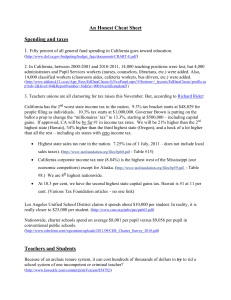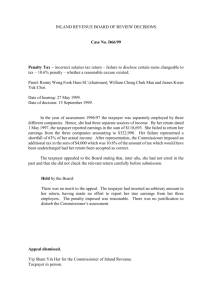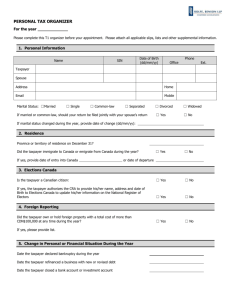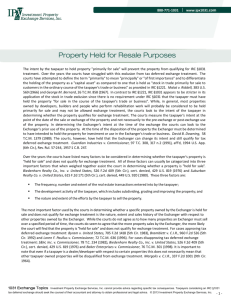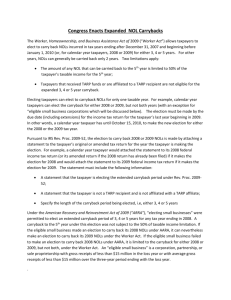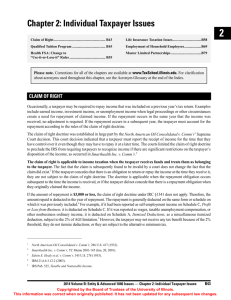The 2015-2016 New York State Budget Bill
advertisement
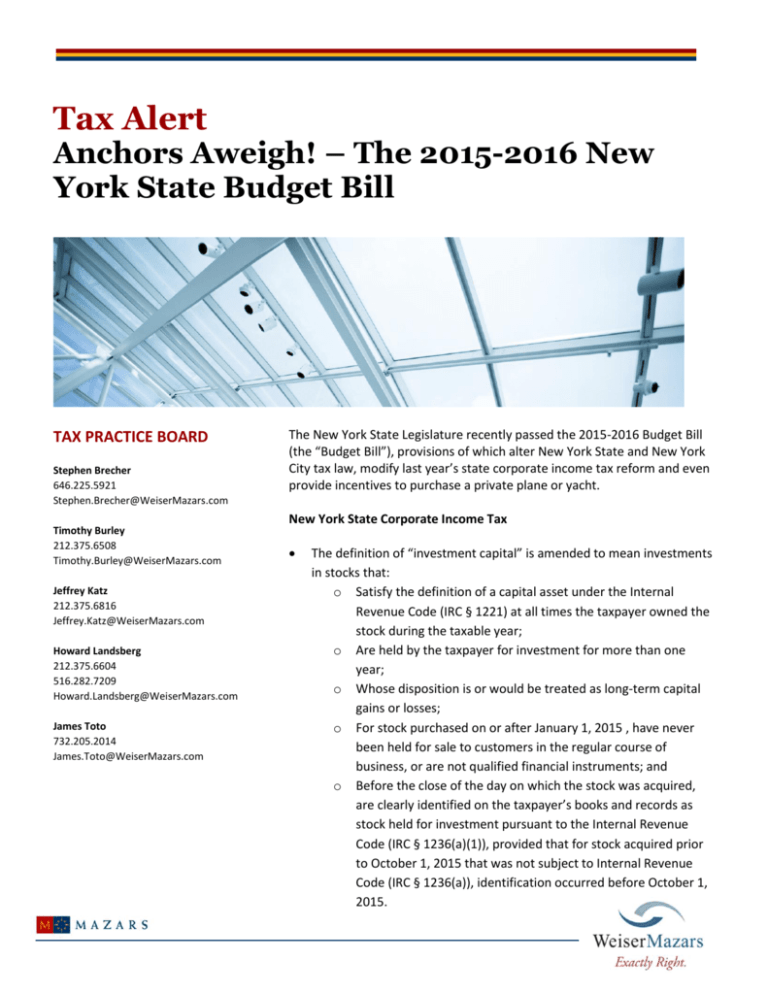
Tax Alert Anchors Aweigh! – The 2015-2016 New York State Budget Bill 2013 TAX PRACTICE BOARD Stephen Brecher 646.225.5921 Stephen.Brecher@WeiserMazars.com The New York State Legislature recently passed the 2015-2016 Budget Bill (the “Budget Bill”), provisions of which alter New York State and New York City tax law, modify last year’s state corporate income tax reform and even provide incentives to purchase a private plane or yacht. Avoid Fiscal CliffNew York State Corporate Income Tax Timothy Burley 212.375.6508 Timothy.Burley@WeiserMazars.com Jeffrey Katz 212.375.6816 Jeffrey.Katz@WeiserMazars.com Howard Landsberg 212.375.6604 516.282.7209 Howard.Landsberg@WeiserMazars.com James Toto 732.205.2014 James.Toto@WeiserMazars.com The definition of “investment capital” is amended to mean investments in stocks that: o Satisfy the definition of a capital asset under the Internal Revenue Code (IRC § 1221) at all times the taxpayer owned the stock during the taxable year; o Are held by the taxpayer for investment for more than one year; o Whose disposition is or would be treated as long-term capital gains or losses; o For stock purchased on or after January 1, 2015 , have never been held for sale to customers in the regular course of business, or are not qualified financial instruments; and o Before the close of the day on which the stock was acquired, are clearly identified on the taxpayer’s books and records as stock held for investment pursuant to the Internal Revenue Code (IRC § 1236(a)(1)), provided that for stock acquired prior to October 1, 2015 that was not subject to Internal Revenue Code (IRC § 1236(a)), identification occurred before October 1, 2015. A financial instrument is now a qualified financial instrument (“QFI”), and entitled to the special apportionment rules contained in last year’s legislation, if it is marked to market under the Internal Revenue Code (IRC § 475 or 1256). Loans secured by real property are not qualified financial instruments. In order for a financial instrument to qualify as a QFI, it must meet the definition and have actually been marked to market, not just merely eligible to be marked to market. Investment income is now limited to 8% of entire net income. If a taxpayer’s investment income, determined without regard to allowable interest deductions, is more than 8% of entire net income, then investment income determined without regard to the interest deductions must be capped at 8% of the taxpayer’s entire net income. For example, if a taxpayer has $100 of entire net income, and $20 of investment income, investment income will be limited to $8 under the new law. A taxpayer can make what is now a revocable election to reduce their investment income by 40%. This is in lieu of computing an actual interest expense attribution to investment income. The 40% is applied after the 8% cap on investment income described above. A net operating loss may be carried back three taxable years, and carried forward 20 years from the year of the loss. No loss can be carried back to a year beginning before January 1, 2015. Accordingly, the first loss year for which a carryback is permitted is the tax year ending December 31, 2016. A taxpayer may make an irrevocable election each tax year to waive the entire carryback period with respect to a net operating loss generated that year. The financial services investment tax credit has been repealed, effective with property placed in service on or after October 1, 2015. Specific apportionment rules for marked to market gains and receipts from the operation of commercial vessels have been enacted. Commencing May 1, 2015, a 2.9% tax is imposed on the gross receipts from the sale of mobile telecommunication services if the customer’s primary use in within the state. The law indicates the service is sourced to the taxing jurisdiction where the mobile telecommunications customer's place of primary use is located, regardless of where the mobile telecommunications service originates, terminates or passes through. A tax of .721% is also imposed on gross receipts relating to customers in the metropolitan commuter transportation district. New York State Sales and Use Tax The Budget Bill enacted a $230,000 cap on the value upon which sales and use tax can be imposed on a vessel, such as a yacht, in New York. The Budget Bill also allowed for an exemption from use tax for vessels not used in New York for at least 90 consecutive days, unless the date the vessel is required to be registered or is actually registered with the state occurs sooner. Certain noncommercial aircraft would no longer be subject to sales or compensating use tax. Implementation of New York City Corporate Tax Reform The most significant changes to the New York City Corporate Income Tax, aligning it with last year’s New York State Corporate Tax Reform, include: o Elimination of the separate bank tax regime o Elimination of the tax on subsidiary capital o Exemption from tax for investment income (also limited to 8% of entire net income) o New net operating loss treatment o Adoption of unitary combined filing rules o Uses “effectively connected income,” a technical term under the Internal Revenue Code, as the basis for taxing non-U.S. corporations o Market-based sourcing All of the above noted changes only apply to C corporations; S corporations and unincorporated entities subject to the Unincorporated Business Tax will continue to be taxed under pre-2015 tax law provisions. New York City did not enact an economic nexus standard except for banks issuing credit cards. New York City is growing its capital tax base, with a revised cap of $10 million. Under prior law, the tax was capped at $1 million. An increased 9% tax rate will apply to financial corporations (including many banks and brokerage firms meeting certain asset and receipts thresholds), compared to an 8.85% tax rate for most other corporations. There are reduced rates for taxpayers with less than $3 million of business income. New York City has adopted reduced tax rates for qualified New York manufacturing corporations. This will apply to manufacturers with allocated business income of less than $40 million. The lowest rate, for manufacturers with less than $10 million of allocated business income, will be 4.425%, with a sliding scale applying higher rates up to the $40 million threshold, where the rate will be the full 8.85%. In a surprising development, the City law will allow the lower rates for manufacturers with facilities located in the State – there will be no requirement to manufacture in the City. New York City is phasing in a single sales factor apportionment formula, to be completed for tax years beginning on or after January 1, 2017. The Budget Bill permits a taxpayer who has no more than $50 million of receipts allocated to New York City to make an election to determine its business allocation percentage based on a weighting of the taxpayer’s property, receipts, and payroll factors (3.5%, 93%, and 3.5%, respectively). The election remains in effect until revoked. Please contact your WeiserMazars tax professional for more information. Harold Hecht, CPA Director, State and Local Tax Group PH: 646.225.5953 Harold.Hecht @WeiserMazars.com Disclaimer of Liability Our firm provides the information in this e-newsletter for general guidance only, and does not constitute the provision of legal advice, tax advice, accounting services, investment advice, or professional consulting of any kind. The information provided herein should not be used as a substitute for consultation with professional tax, accounting, legal, or other competent advisers. Before making any decision or taking any action, you should consult a professional adviser who has been provided with all pertinent facts relevant to your particular situation. Tax articles in this e-newsletter are not intended to be used, and cannot be used by any taxpayer, for the purpose of avoiding accuracy-related penalties that may be imposed on the taxpayer. The information is provided “as is,” with no assurance or guarantee of completeness, accuracy, or timeliness of the information, and without warranty of any kind, express or implied, including but not limited to warranties of performance, merchantability, and fitness for a particular purpose. WeiserMazars LLP is an independent member firm of Mazars Group. CONFIDENTIALITY NOTICE: The information contained in this communication may be privileged, confidential and protected from use and disclosure. If you are not the intended recipient, or responsible for delivering this message to the intended recipient, you are hereby notified that any review, disclosure, distribution or copying of this communication is strictly prohibited. If you have received this communication in error please notify the sender immediately by replying to the message and deleting it from your computer. Thank you for your cooperation. WeiserMazars LLP



